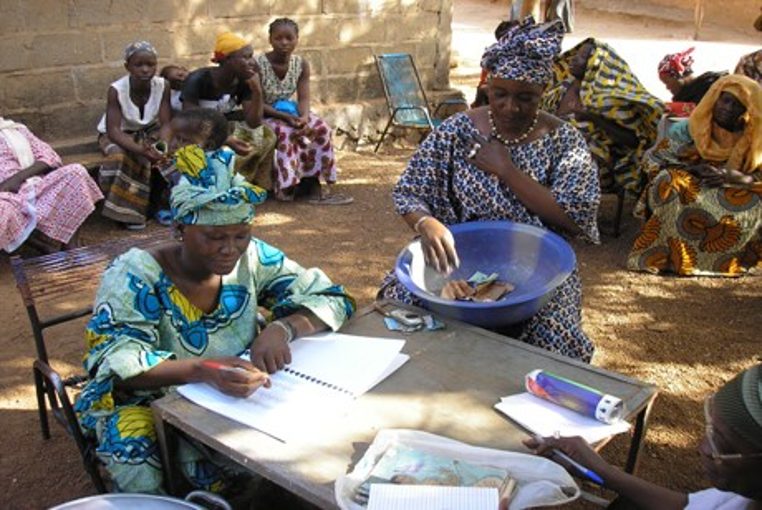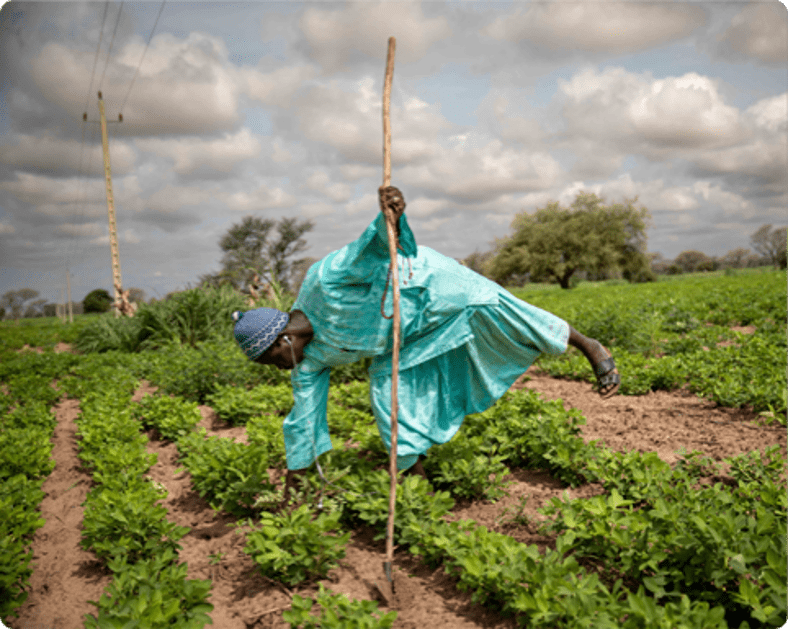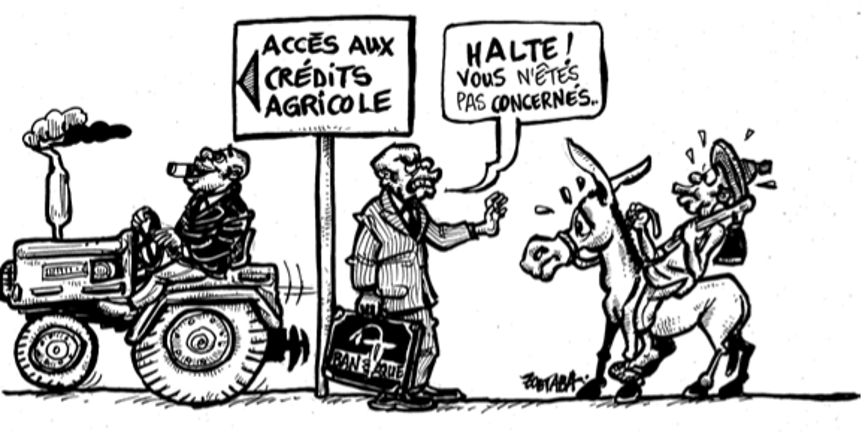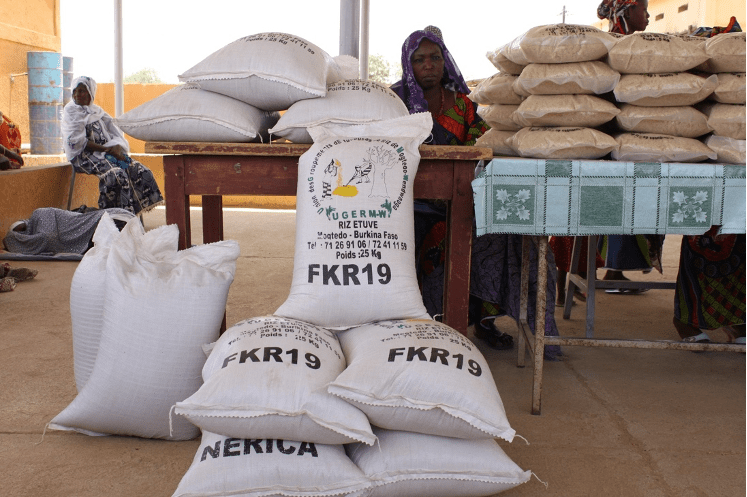African agriculture suffers from a chronic lack of funding. Financing is one of the main obstacles to the growth of the agricultural sector, especially for small-scale farms. Only 10% of producers, usually those integrated into value chains for cash crops, have access to credit. Direct financing of rural activities has always been considered, in general, as costly and risky, and for this reason, it has remained very limited.
While financial products and systems have improved in many urban areas of the Global South, their availability lags significantly in rural regions. Money tends to flow toward money, rather than toward labor or land. It doesn’t flow most abundantly to the sectors and regions where it is scarcest. Consequently, financing tends to focus more on export cash crops (cotton, coffee, cocoa, rubber, etc.) and neglects domestic food crops, which are also in need of funds.
In general, agricultural and rural financing can be characterized by two institutional forms: those that start with the financial sector and its intermediary institutions (banks, microfinance institutions, insurance or guarantee funds) as the basis for organizing financial services and financial inclusion, and those that contract their financing articulated with the organization of agricultural and food value chains.
The recognition of the crucial importance of support for agriculture is stronger than ever. It is estimated that modernizing agriculture in Sub-Saharan Africa alone would require an annual volume of capital of more than 200 billion euros. Agricultural financing policies should be re-legitimized to address the numerous imperfections in financial markets. Public and private funds, including those from development agencies, foundations, companies, and NGOs, sometimes carrying innovations, should be channeled into incentive mechanisms to support agriculture, fisheries, livestock, and sustainable forestry operations. This particularly includes investments that adhere to social and environmental criteria.
The position of the African Union Commission is now very clear: “Member States must focus more on this commitment by increasing public investments in agriculture. They must improve access to and use of financial services by smallholder farmers/rural households, who, in turn, will increase investments in the agricultural sector as they represent the largest and most important segment of agricultural value chains.”
The time is no longer for the formulation of general, overly normative policies regarding rural credit. Its future lies in the combination of diverse instruments and mechanisms, close to borrowers and savers, if not managed at least controlled by the stakeholders themselves, allowing for better adaptation of credit to various needs (production, but also small investments, consumption, social obligations) and in the development of a mutualistic spirit.
1. The Six Fundamental Questions of Rural Financing

Image credit : google
- Agricultural credit or rural credit? Credit operations mainly focus on agricultural production in the strict sense (input supply, equipment). The financial services offered are actually poorly adapted to the systemic and fluctuating nature of farmers’ needs, which include various types of crops, both subsistence and cash crops, various forms of livestock, and non-agricultural activities (processing, marketing, craftsmanship), following a schedule dictated by the seasons. Financial services for agriculture can only be effective if they are integrated into a rural economy supported by functional services: input supply for production, marketing, technical advice, dissemination of management models, market information systems, etc.
- Productive or unproductive credit? Social credits related to family needs (additional food, health, education, dowry, funerals, etc.) are always suspect due to the risk of non-repayment. Nevertheless, differentiation is not easy to make when unproductive credit acts as a stimulus to agricultural, livestock, or fishing activities.
- Hot money or cold money? Cold money comes from external sources, such as the government or donors; it is scarce and can be diverted or not repaid. Hot money, on the other hand, comes from farmers themselves, deserving careful attention and enabling social control. In Tanzania, for example, only 40% of rural residents have access to financial services, and among them, three-quarters obtain their loans from savings and credit associations or informal lenders, with very few having access to banking services. However, it would be erroneous to too systematically oppose official and informal financial sectors. Many links exist between the two: for instance, the sums allocated by rotating savings and credit associations to their members are often deposited in banks, as are monetary reserves accumulated after marketing.
2. A widespread deficiency

Image credit : google
In 2003, during the African Union summit held in Maputo, Mozambique, heads of state and government committed to investing 10% of the national budget in agriculture. This initiative, commonly referred to as the Maputo Declaration, is the primary instrument that leaders established when launching the Comprehensive Africa Agriculture Development Programme (CAADP) to achieve an annual agricultural growth rate of 6%. This commitment has remained unchanged over time and has formed the basis for subsequent AU declarations on agriculture-focused development, such as the 2014 Malabo Declaration on Accelerated Agricultural Growth and Transformation for Shared Prosperity and Improved Livelihoods.
Two decades after the Maputo Declaration, very few countries have reached the 10% target. Five countries (Burkina Faso, Ethiopia, Malawi, Mali, and Niger) consistently met the target between 1980, while Benin, Mozambique, Senegal, and Sierra Leone are countries that reached the goal only in certain years following the commitment. The share of agriculture in the continent’s total public expenditure has steadily declined over time, dropping from an average of about 7% per year in the 1980s to less than 3% per year on average over the last decade.
Regarding the indicator on smallholder farmers/rural households’ access to financial services and their use in agricultural transactions, the results suggest poor performance: only seven countries (Eswatini, Mauritius, Morocco, Nigeria, Seychelles, Tunisia, and Zimbabwe) were on track for access to agricultural services. Only sixteen countries scored 30% or higher on this indicator.
Certainly, the 10% numerical target may seem arbitrary. However, given that public spending on agriculture has a high return in terms of economic growth and that agricultural growth has been more effective in reducing poverty than growth from other sectors, the continued decline of agriculture’s share in total public expenditure in Africa is indeed concerning. The agriculture sector’s contribution to GDP has remained at around 15% on average across the continent since the 1980s, even though the sector is supposed to address challenges such as food security, malnutrition, poverty reduction, and resilience-building while dealing with issues like climate change, natural resource degradation, and the spread of pests and diseases.
3. The financing needs

Image credit : google
In 2016, the African Development Bank estimated that the transformation of 18 agri-food value chains in Africa would cost up to $400 billion over 10 years. In 2020, CERES 2030, on the other hand, considered that eradicating hunger and doubling the incomes of small-scale producers would require $45 billion annually. In 2022, S.W. Omamo and A. Mill from New Growth International (NGI) proposed a new assessment of the required investment amounts to transform Africa’s agri-food systems with higher productivity and lower production costs to achieve a significant reduction in food insecurity. Based on the Food Systems Performance Index (NGI Index), the study estimates that the necessary transformation of food systems in Africa will require $76.8 billion per year until 2030, with $15.4 billion from the public sector and $61.4 billion from the private sector. Investment levels by country highlight the particularly significant needs of Ethiopia ($8 billion/year), Niger ($6.5), Tanzania ($6.1), Morocco ($5.4), Mozambique ($4.5), Mali ($4.3), Uganda ($4.1), Algeria ($4.1), and Nigeria ($2.9).
As shown in Table 1, the financing priorities that emerge from an analysis of public expenditures suggest a distribution across four levels of intervention for the entire continent. The needs for transformation and commercialization infrastructure are probably underestimated.
4. Institutional financing

Image credit : google
In Sub-Saharan Africa, agricultural development banks, conceived as the strong arms of the states, were widely introduced in the 1970s as a significant means to promote economic development, wealth creation, and employment in rural areas. Most of them were state-owned and funded by governments and international donor organizations.
Public banks were criticized for their inefficiency, recurring deficits, and lack of transparency. Besides some of them being used for political purposes and falling victim to nepotism and corruption, many of these institutions faced significant issues, such as the absence of distribution networks and a focus on providing loans without offering savings options simultaneously. For these reasons, most of them were not in an institutional position to generate the expected effects and therefore achieve their initial goal.
Public authorities often imposed debt write-offs, fueling some confusion in the minds of farmers between grants and loans. The liquidation of the Bank for Agricultural Financing (BFA) in Côte d’Ivoire in 2014, ten years after its creation, confirmed the difficulties of such institutions. After announcing the creation of an agricultural bank in 2011, Cameroon finally abandoned the idea in 2018. In West Africa, only the Senegalese Agricultural Bank, the National Agricultural Development Bank of Mali, and the Agricultural Bank of Niger have remained.
The vulnerability of banks dedicated to agriculture is a well-known fact, common to all states. The low proportion of funding allocated to agriculture is explained by specific constraints inherent to this sector: high production risk (high likelihood of droughts, technical failures, phytosanitary attacks, or animal epidemics); market risks (price volatility, market instability) that can affect the repayment capacity of credit beneficiaries.
When banks target peasant farmers with little or no collateral, they declare exposure to default levels that are difficult to reconcile with the prudential rules set by central banks. Seasonal loans often have to be repaid in a single installment, knowing that producers generate monetary income only at harvest and do not always have intermediate incomes to make staggered repayments. When this single installment experiences repayment delays, such as unfavorable market conditions at harvest, banks are required to reclassify the outstanding installment and create a provision. On the side of producers, the distance to service points and the costs to access financial services are additional obstacles.
As only one actor among others in agricultural financing today, are agricultural banks expected to play a significant role in the future? In fact, since the 2010s, commercial banks have been cautiously opening up to family agriculture. Some are forming alliances with microfinance institutions that have decentralized networks capable of being in proximity to farmers. Given the significant risks inherent in agricultural activities, going beyond this will require improvements in financing instruments and guarantee mechanisms that can be coupled with digitization to facilitate the work of banks while reducing their costs.
5. Value Chain Financing

Image credit : google
This type of financing is not new. Before independence, cotton producers in Mali and peanut growers in Senegal received seasonal credits from the then-public processing companies, while tea, coffee, and tobacco growers in Tanzania and elsewhere were financed through marketing boards.
Marketing boards were widespread in the 1960s and 1980s, often encompassing the entire agricultural development of a region. However, for reasons similar to those of specialized agricultural banks, they were very often inefficient and financially unsustainable, at least under the prevailing conditions. That’s why most marketing boards were abolished as part of structural adjustment measures. If they survived (for example, for cotton in many West African countries or cocoa in Ghana and Ivory Coast), their role and power were generally reduced.
In fact, the term “value chain finance” is used to address various situations: informal in-kind credit provided by input suppliers to a group of farmers, partial advance payment for future harvests by the buyer, farmer groups organizing to store their production to obtain credit from a microfinance institution, provision of services by private providers funded by buyers. Each of these situations falls under the term.
Innovations are an integral part of value chain finance development. It is essential to have a good understanding of the context, value chain processes, economic models, and financial and technological innovations that can be implemented.
The Warrantage System
Before the 1990s, the offer relied on three types of credit: compulsory savings credit, solidarity group credit, and project guarantee fund credit (Traoré, Bocoum, and Tamini, 2020). Later on, new credit variants with collateral constituted by agricultural product stocks were introduced. This is the case of warrantage credit.
Warrantage, or credit backed by stored stocks, has been booming in smallholder agriculture. It allows guaranteeing a loan up to 60% or even 80% of the value of a deposited harvest. Its operation is simple. After the harvest, the farmer deposits a certain quantity of their production with a storage organization (third-party storage) that attests to the existence, quality, and quantity of the stock and ensures its monitoring. The farmer receives a storage receipt (warrant). Subsequently, they can apply for a loan, which will be guaranteed by the warrant held by the lender. When the production is sold, the farmer and the buyer will go to the lending organization that will “release” the production. In practice, warrantage, a straightforward system, is most efficient when it is accompanied by the involvement of farmers’ organizations and microfinance institutions.
More and more experiences have seen small producers benefit from this system. The case of Burkina Faso is interesting. The company SEGAS has strived to establish a clientele among producer organizations. It operates in nearly 15 storage sites throughout the country. It receives goods, weighs and repackages them, treats them with an insecticide, and then issues warehouse receipts to depositors, allowing them to obtain credit from a microfinance institution. It also provides them with inputs and market research. Farmers are willing to pay SEGAS-BF twice the rate charged by their own producer organizations for third-party storage services. It adds value to the system by ensuring quality and providing greater flexibility and complementary services.
One of the great advantages of obtaining loans through buyers is that they are familiar with the requirements of sales markets, especially if they are active in crop production. Often, credit is part of comprehensive financial and non-financial service packages, including pricing or price-setting rules for the products sold. Everything is financed by marketing and its margins.
Read also : Harvesting Hope: How Better Storage Solutions Can Empower Farmers
Read also : principles of plant ( पौधे के सिद्धांत ) पादप विकास के चार चरण कौन-कौन से हैं? पौधों की वृद्धि के सिद्धांत
